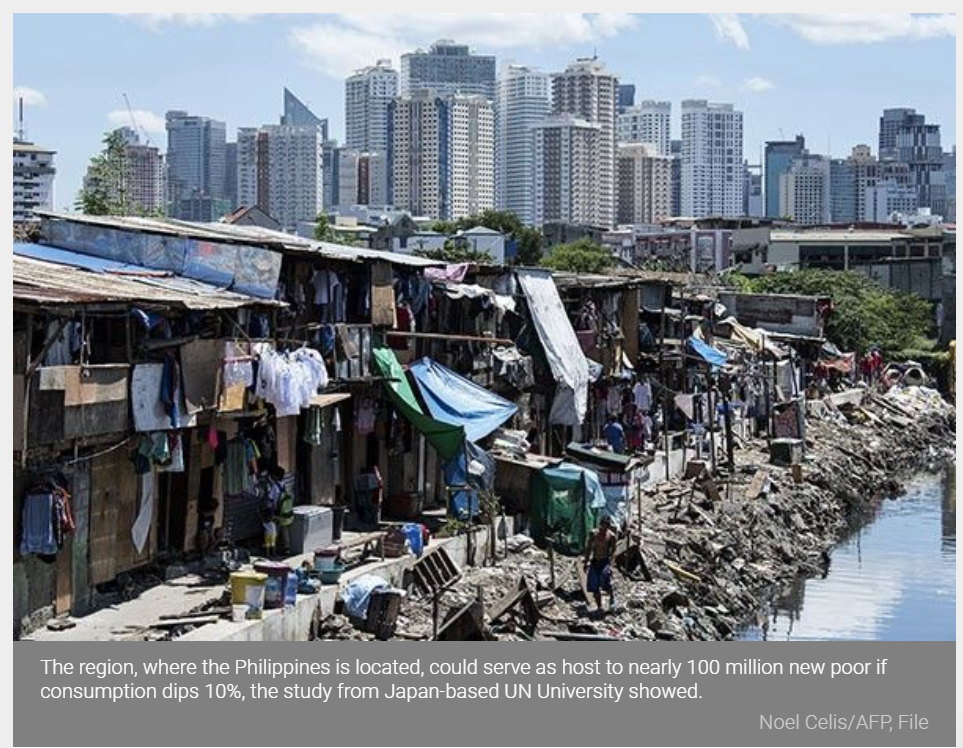Absent gov’t support, coronavirus seen to put 40% of new poor in East Asia and Pacific
MANILA, Philippines — Without social aid, the economic slump from the coronavirus global pandemic would likely wipe out three decades of gains in fighting poverty, with nearly half of new poor people coming from East Asia and the Pacific, a new study showed.
The region, which includes the Philippines, could host “40% of the new poor” in a scenario of per capita income declining 5% and poverty threshold of $5.5 earnings a day, a working paper written for the Japan-based United Nations University said.
In absolute values, that would mean an additional 97.6 million people sliding down back to poverty this year from 2018 levels, an indication of the scale of damage the health crisis poses on developing countries where healthcare systems come under strain from a rise in infections.
“While these welfare impacts of COVID-19 pandemic could be overestimated, there is no doubt that the real outcomes will be dramatic across developing countries,” the 14-page paper authored by Andy Sumner, Chris Hoy and Eduardo Ortiz-Juarez stated.
The Philippines, specifically, is not expected to reach upper-middle income status this year, with economic managers resigned to a likelihood of a gross domestic product (GDP) contraction ranging from 0.6% estimated by the National Economic and Development Authority and a higher 1% by the finance department.
The study used scenarios of 5%, 10% and 20% drop in per capita income, particularly showing that the deeper the economic plunge, the bigger the number of poor people across continents. The same was true as the poverty threshold rises from $1.9 a day to $5.5, putting a greater number of people at risk of turning poor with depreciated incomes.
For instance, from 97.6 million new poor people in East Asia and the Pacific at 10% decrease in consumption, the number would more than double to 218.6 million under a 20% slump, the study showed.
At the global level, the study said the spread of coronavirus disease-2019 (COVID-19), and the halt on consumption activity it brings, create a “real challenge” to economies in ending poverty by 2030 as targeted under the UN Sustainable Development Goals.
“Focusing on a contraction per capita income or consumption of 10%, poverty headcount rates could increase for the first time since 1990 in East Asia and the Pacific, Latin America and the Caribbean and South Asia…,” the study stated.
The same level of consumption decline would “erase the progress” of Sub-Saharan Africa in eradicating extreme poverty in recent years. As it is, the region still suffers from “already high poverty levels.”
While painting a bleak outlook, the study was clear that it did not take into account government interventions to “mitigate” the impact of the outbreak on the poor, and therefore can lower anticipated poverty levels as a result of COVID-19 disruptions.
More than monetary incomes however, the study said greater ramifications are expected on human indicators such as infant and maternal mortality, as well as malnourishment.
“The severity of effects will depend on how long the pandemic lasts, and on how the national governments and international community reacts,” it said.
Source: https://www.philstar.com/business/2020/04/10/2006579/absent-govt-support-coronavirus-seen-put-40-new-poor-east-asia-and-pacific


 Thailand
Thailand




